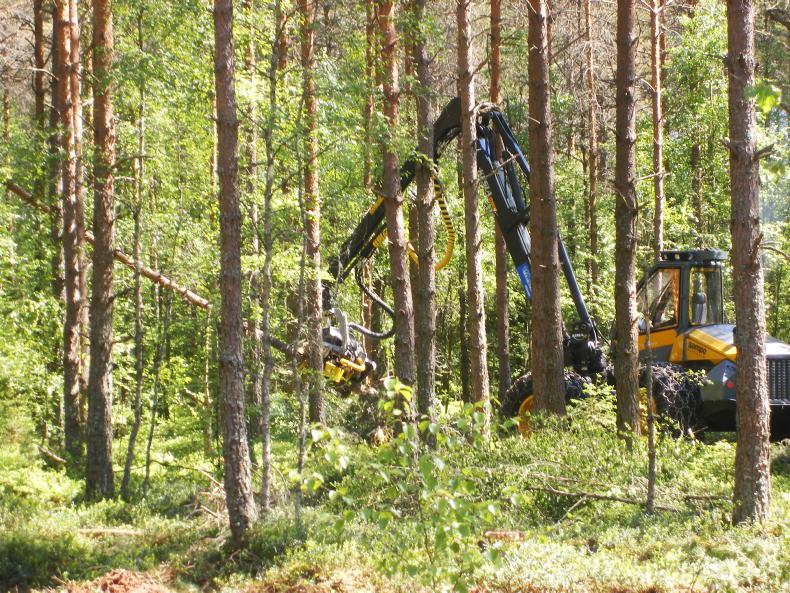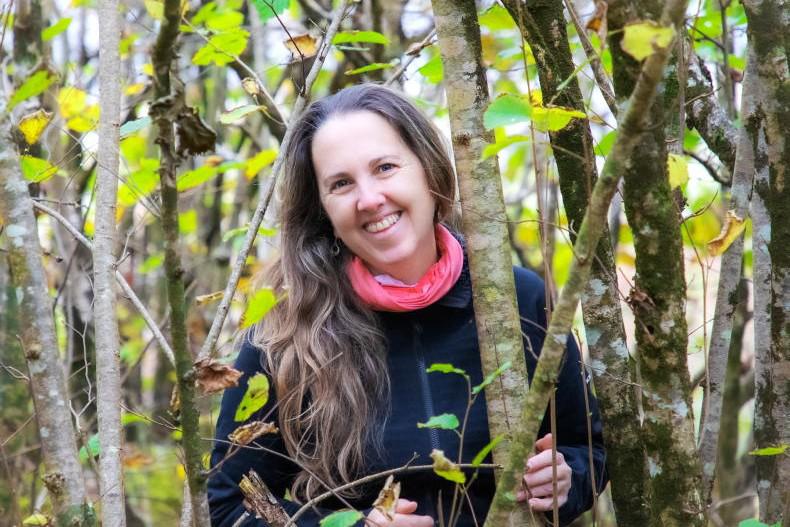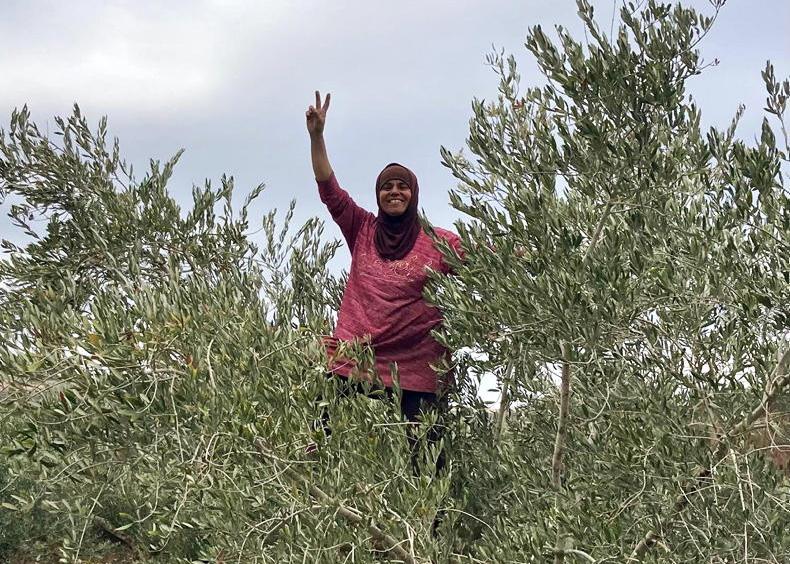Since the forestry licence crisis arose 18 months ago, comparisons have been made between Ireland and other European countries, especially on afforestation and felling licences.
The recent IFA survey of felling licence procedures in some member states was assessed from a grower’s perspective. Now, Michael Moroney, CEO of the Association of Farm & Forestry Contractors (FCI), has conducted a similar study.
The FCI assessed felling licences in Sweden, Finland, Germany, Portugal, Denmark and Lithuania.
The study was carried out in collaboration with CEETTAR, the European organisation of agricultural, rural and forestry contractors, which represents 150,000 contractors.
While Moroney’s study looks in detail at six countries, it is worth paying particular attention to Ireland’s main competitors – Sweden, Finland and Germany – in the UK market. This is Ireland’s only export market for sawn wood and the main market for wood-based panels.
Sweden and Finland have 56% of the UK-sawn softwood market share while Germany is a major competitor in the particleboard and fibreboard market.
Felling licences
A felling licence for thinning is not a requirement in any of the countries surveyed. In Germany, “only clear cuts, where all trees are to be removed, require permission”, says Marlen Brinkord of the Germany Association of Forestry Contractors. “It is not obligatory to wait for the trees to fully mature,” she maintains.
Claus Danefeldt Clemmensen of the Danish Contractors Association says: “As a forest owner, you must only fell your trees when they are fully mature.
We have a duty to register in advance of felling to the Swedish Forest Agency
“It is up to the forest owner to assess when the trees are mature and he/she does not need permission to cut the trees. If, on the other hand, the ministry of the environment discovers that you harvest your trees before they are fully mature, fines will be imposed. But it happens very rarely.”
Anders Drottja of the Federation of Swedish Farmers says that “as a rule” felling permits “on ordinary forest land” are not required.
“We have a duty to register in advance of felling to the Swedish Forest Agency (SFA) and they have six weeks to react if they so wish,” he says.
“If there is no response within this period, the owner can harvest. On the other hand, if the SFA [questions] intended felling, it can be a very long process to obtain a felling permit,” he says.
In Finland, notification has to be submitted to the Finnish Forest Centre (FCC) within a minimum 10 days prior to harvesting. FCC is a state-funded organisation whose task is to enforce the forestry act and to promote sustainable forestry.
Apart from Portugal, all clearfelled areas have to be replanted
“If there is anything which has to be taken into account in the harvesting operation or which could prevent the operation, the FCC has to inform forest owner within 10 days maximum,” explains Simo Jaakkola of the Finnish Forestry and Plant Contractors Association.
A forest use declaration is not required for “felling for household use” or “felling of small-sized tree stand [less than 0.5ha]” according to Finland’s Forestry Act.
Apart from Portugal, all clearfelled areas have to be replanted. Timing varies widely between final harvest and replanting. In Denmark, the owner has up to 10 years to replant while Finland allows up to three years.
Reforestation must take place within three years in southern Sweden and five years in northern Sweden, while three years is the maximum period in Lithuania.
Comparisons with Ireland
Felling licence procedures differ hugely between Ireland and other member states.
For example, countries such as Sweden, Finland, Denmark, Germany – and France, according to the IFA survey – regard thinning as good silvicultural practice so felling licences are not required, unlike Ireland.
In the case of clearfells, the forest authorities have to respond within strict timescales should they question a felling operation.
This timescale is measured in days in Finland and weeks elsewhere, rather than months and even years as is the case in Ireland.
The call by the Oireachtas committee for a detailed survey of forestry licences– planting, felling and roading – in member states is timely
As a result, it is clear from the FCI and the IFA licence surveys that Irish forest owners, contractors and sawmillers are at a serious competitive disadvantage compared with their European counterparts.
These countries encourage rather than discourage their forestry and forest products sectors while maintaining biodiversity and other non-wood benefits.
The call by the Oireachtas committee for a detailed survey of forestry licences– planting, felling and roading – in member states is timely and needs to be carried out independently by the relevant working group in Project Woodland.
Project Woodland and positive stakeholder engagement
It’s almost four months since Project Woodland was launched. Donal Whelan, who represents the Irish Timber Growers Association (ITGA) on the project, gives his impressions of the forum so far.
“While it has its critics, there is also an interesting dynamic at play where both the forestry sector and Irish environmentalists essentially want to achieve similar goals,” he says.
“These can be summarised as more planting of the right trees in the right places and the ongoing sustainable management of our woodlands.
“While the species of trees to be planted and how more biodiversity can be encouraged will be actively debated, the initiative may prove to be a model worth exploring further in the agriculture sector where the project is shown to make speedy progress in addressing both forestry and related environmental issues.”
Whelan maintains the forum provided by Project Woodland, where environmentalists and farm forest owners and their representatives are working together, may prove to be a starting point for a critical dialogue.
Stakeholders
The stakeholders involved in Project Woodland represent diverse groups where economic, environmental and social interests are all well represented.
Whelan is comparing the exercise with the Agri-Food 2030 forum.
“Members of the Environmental Pillar (EP) have publicly resigned from the Agri-Food 2030 Strategy Committee, having come to the conclusion that the current draft strategy is inadequate to meet Ireland’s social and environmental challenges,” he says.
“However, the EP and many other environmental groups are participating and fully engaging with Project Woodland.”
He agrees with Justin McCarthy’s recent call for farmers and environmental groups to work together as they “could deliver so much in relation to reducing the environmental footprint of food production, not just in Ireland but globally”.
New model
Whelan says this will require a new model or platform for farmers and environmental groups to come together.
“The forestry sector is hoping that Project Woodland will provide a basis for successful multi-stakeholder engagement and, ultimately, be a positive harbinger for the wider agriculture sector.”
Since the forestry licence crisis arose 18 months ago, comparisons have been made between Ireland and other European countries, especially on afforestation and felling licences.
The recent IFA survey of felling licence procedures in some member states was assessed from a grower’s perspective. Now, Michael Moroney, CEO of the Association of Farm & Forestry Contractors (FCI), has conducted a similar study.
The FCI assessed felling licences in Sweden, Finland, Germany, Portugal, Denmark and Lithuania.
The study was carried out in collaboration with CEETTAR, the European organisation of agricultural, rural and forestry contractors, which represents 150,000 contractors.
While Moroney’s study looks in detail at six countries, it is worth paying particular attention to Ireland’s main competitors – Sweden, Finland and Germany – in the UK market. This is Ireland’s only export market for sawn wood and the main market for wood-based panels.
Sweden and Finland have 56% of the UK-sawn softwood market share while Germany is a major competitor in the particleboard and fibreboard market.
Felling licences
A felling licence for thinning is not a requirement in any of the countries surveyed. In Germany, “only clear cuts, where all trees are to be removed, require permission”, says Marlen Brinkord of the Germany Association of Forestry Contractors. “It is not obligatory to wait for the trees to fully mature,” she maintains.
Claus Danefeldt Clemmensen of the Danish Contractors Association says: “As a forest owner, you must only fell your trees when they are fully mature.
We have a duty to register in advance of felling to the Swedish Forest Agency
“It is up to the forest owner to assess when the trees are mature and he/she does not need permission to cut the trees. If, on the other hand, the ministry of the environment discovers that you harvest your trees before they are fully mature, fines will be imposed. But it happens very rarely.”
Anders Drottja of the Federation of Swedish Farmers says that “as a rule” felling permits “on ordinary forest land” are not required.
“We have a duty to register in advance of felling to the Swedish Forest Agency (SFA) and they have six weeks to react if they so wish,” he says.
“If there is no response within this period, the owner can harvest. On the other hand, if the SFA [questions] intended felling, it can be a very long process to obtain a felling permit,” he says.
In Finland, notification has to be submitted to the Finnish Forest Centre (FCC) within a minimum 10 days prior to harvesting. FCC is a state-funded organisation whose task is to enforce the forestry act and to promote sustainable forestry.
Apart from Portugal, all clearfelled areas have to be replanted
“If there is anything which has to be taken into account in the harvesting operation or which could prevent the operation, the FCC has to inform forest owner within 10 days maximum,” explains Simo Jaakkola of the Finnish Forestry and Plant Contractors Association.
A forest use declaration is not required for “felling for household use” or “felling of small-sized tree stand [less than 0.5ha]” according to Finland’s Forestry Act.
Apart from Portugal, all clearfelled areas have to be replanted. Timing varies widely between final harvest and replanting. In Denmark, the owner has up to 10 years to replant while Finland allows up to three years.
Reforestation must take place within three years in southern Sweden and five years in northern Sweden, while three years is the maximum period in Lithuania.
Comparisons with Ireland
Felling licence procedures differ hugely between Ireland and other member states.
For example, countries such as Sweden, Finland, Denmark, Germany – and France, according to the IFA survey – regard thinning as good silvicultural practice so felling licences are not required, unlike Ireland.
In the case of clearfells, the forest authorities have to respond within strict timescales should they question a felling operation.
This timescale is measured in days in Finland and weeks elsewhere, rather than months and even years as is the case in Ireland.
The call by the Oireachtas committee for a detailed survey of forestry licences– planting, felling and roading – in member states is timely
As a result, it is clear from the FCI and the IFA licence surveys that Irish forest owners, contractors and sawmillers are at a serious competitive disadvantage compared with their European counterparts.
These countries encourage rather than discourage their forestry and forest products sectors while maintaining biodiversity and other non-wood benefits.
The call by the Oireachtas committee for a detailed survey of forestry licences– planting, felling and roading – in member states is timely and needs to be carried out independently by the relevant working group in Project Woodland.
Project Woodland and positive stakeholder engagement
It’s almost four months since Project Woodland was launched. Donal Whelan, who represents the Irish Timber Growers Association (ITGA) on the project, gives his impressions of the forum so far.
“While it has its critics, there is also an interesting dynamic at play where both the forestry sector and Irish environmentalists essentially want to achieve similar goals,” he says.
“These can be summarised as more planting of the right trees in the right places and the ongoing sustainable management of our woodlands.
“While the species of trees to be planted and how more biodiversity can be encouraged will be actively debated, the initiative may prove to be a model worth exploring further in the agriculture sector where the project is shown to make speedy progress in addressing both forestry and related environmental issues.”
Whelan maintains the forum provided by Project Woodland, where environmentalists and farm forest owners and their representatives are working together, may prove to be a starting point for a critical dialogue.
Stakeholders
The stakeholders involved in Project Woodland represent diverse groups where economic, environmental and social interests are all well represented.
Whelan is comparing the exercise with the Agri-Food 2030 forum.
“Members of the Environmental Pillar (EP) have publicly resigned from the Agri-Food 2030 Strategy Committee, having come to the conclusion that the current draft strategy is inadequate to meet Ireland’s social and environmental challenges,” he says.
“However, the EP and many other environmental groups are participating and fully engaging with Project Woodland.”
He agrees with Justin McCarthy’s recent call for farmers and environmental groups to work together as they “could deliver so much in relation to reducing the environmental footprint of food production, not just in Ireland but globally”.
New model
Whelan says this will require a new model or platform for farmers and environmental groups to come together.
“The forestry sector is hoping that Project Woodland will provide a basis for successful multi-stakeholder engagement and, ultimately, be a positive harbinger for the wider agriculture sector.”










SHARING OPTIONS